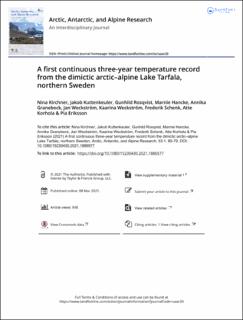| dc.contributor.author | Kirchner, Nina | |
| dc.contributor.author | Kuttenkeuler, Jakob | |
| dc.contributor.author | Rosqvist, Gunhild Ninis | |
| dc.contributor.author | Hancke, Marnie | |
| dc.contributor.author | Granebeck, Annika | |
| dc.contributor.author | Weckström, Jan | |
| dc.contributor.author | Weckström, Kaarina | |
| dc.contributor.author | Schenk, Frederik | |
| dc.contributor.author | Korhola, Atte | |
| dc.contributor.author | Eriksson, Pia | |
| dc.date.accessioned | 2022-04-04T11:32:35Z | |
| dc.date.available | 2022-04-04T11:32:35Z | |
| dc.date.created | 2021-08-19T13:05:32Z | |
| dc.date.issued | 2021 | |
| dc.identifier.issn | 1523-0430 | |
| dc.identifier.uri | https://hdl.handle.net/11250/2989582 | |
| dc.description.abstract | Arctic lakes are exposed to warming during increasingly longer ice-free periods and, if located in glaciated areas, to increased inflow of meltwater and sediments. However, direct monitoring of how such lakes respond to changing environmental conditions is challenging not only because of their remoteness but also because of the scarcity of present and previously observed lake states. At the glacier-proximal Lake Tarfala in the Kebnekaise Mountains, northern Sweden, temperatures throughout the water column at its deepest part (50 m) were acquired between 2016 and 2019. This three-year record shows that Lake Tarfala is dimictic and is overturning during spring and fall, respectively. Timing, duration, and intensity of mixing processes, as well as of summer and winter stratification, vary between years. Glacial meltwater may play an important role regarding not only mixing processes but also cooling of the lake. Attribution of external environmental factors to (changes in) lake mixing processes and thermal states remains challenging owing to for example, timing of ice-on and ice-off but also reflection and absorption of light, both known to play a decisive role for lake mixing processes, are not (yet) monitored in situ at Lake Tarfala. | en_US |
| dc.language.iso | eng | en_US |
| dc.publisher | Taylor and Francis | en_US |
| dc.rights | Navngivelse 4.0 Internasjonal | * |
| dc.rights.uri | http://creativecommons.org/licenses/by/4.0/deed.no | * |
| dc.title | A first continuous three-year temperature record from the dimictic arctic–alpine Lake Tarfala, northern Sweden | en_US |
| dc.type | Journal article | en_US |
| dc.type | Peer reviewed | en_US |
| dc.description.version | publishedVersion | en_US |
| dc.rights.holder | Copyright 2021 The Author(s) | en_US |
| cristin.ispublished | true | |
| cristin.fulltext | original | |
| cristin.qualitycode | 1 | |
| dc.identifier.doi | 10.1080/15230430.2021.1886577 | |
| dc.identifier.cristin | 1927297 | |
| dc.source.journal | Arctic, Antarctic and Alpine research | en_US |
| dc.source.pagenumber | 69-79 | en_US |
| dc.identifier.citation | Arctic, Antarctic and Alpine research. 2021, 53 (1), 69-79. | en_US |
| dc.source.volume | 53 | en_US |
| dc.source.issue | 1 | en_US |

